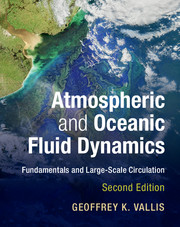Book contents
- Frontmatter
- Dedication
- Contents
- Preface
- Notation
- PART I FUNDAMENTALS OF GEOPHYSICAL FLUID DYNAMICS
- PART II WAVES, INSTABILITIES AND TURBULENCE
- PART III LARGE-SCALE ATMOSPHERIC CIRCULATION
- 14 The Overturning Circulation: Hadley and Ferrel Cells
- 15 Zonally-Averaged Mid-Latitude Atmospheric Circulation
- 16 Planetary Waves and Zonal Asymmetries
- 17 The Stratosphere
- 18 Water Vapour and the Tropical Atmosphere
- PART IV LARGE-SCALE OCEANIC CIRCULATION
- References
- Index
16 - Planetary Waves and Zonal Asymmetries
from PART III - LARGE-SCALE ATMOSPHERIC CIRCULATION
Published online by Cambridge University Press: 09 June 2017
- Frontmatter
- Dedication
- Contents
- Preface
- Notation
- PART I FUNDAMENTALS OF GEOPHYSICAL FLUID DYNAMICS
- PART II WAVES, INSTABILITIES AND TURBULENCE
- PART III LARGE-SCALE ATMOSPHERIC CIRCULATION
- 14 The Overturning Circulation: Hadley and Ferrel Cells
- 15 Zonally-Averaged Mid-Latitude Atmospheric Circulation
- 16 Planetary Waves and Zonal Asymmetries
- 17 The Stratosphere
- 18 Water Vapour and the Tropical Atmosphere
- PART IV LARGE-SCALE OCEANIC CIRCULATION
- References
- Index
Summary
PLANETARY WAVES ARE LARGE-SCALE ROSSBY WAVES in which the potential vorticity gradient is provided by differential rotation (i.e., the beta-effect). They are ubiquitous in Earth's atmosphere and almost certainly in other planetary atmospheres. They propagate horizontally over the two Poles, and they propagate vertically into the stratosphere and beyond. In the previous chapter we saw that it is the propagation of Rossby waves away from their mid-latitude source that gives rise to the mean eastward eddy-driven jet. In this chapter we will see that the dynamics of such waves also largely determines the large-scale zonally asymmetric circulation of the mid-latitude atmosphere. In the first few sections we discuss the properties and propagation of planetary waves themselves, and in many ways these sections are a continuation of Chapter 6. We then look more specifically at planetary waves forced by surface variations in topography and thermal properties, for it is these waves that give rise to the zonally asymmetric circulation.
In proceeding this way we are dividing our task of constructing a theory of the general circulation of the extratropical atmosphere into two. The first task (Chapters 14 and 15) was to understand the zonally averaged circulation and the transient zonal asymmetries by supposing that, to a first approximation, this circulation is qualitatively the same as it would be if the boundary conditions were zonally symmetric, with no mountains or land–sea contrasts. Given the statistically zonally symmetric circulation, the second task is to understand the zonally asymmetric circulation. We may do this by supposing that the latter is a perturbation on the former, and using a theory linearized about the zonally symmetric state. It is by no means obvious that such a procedure will be successful, for it depends on the nonlinear interactions among the zonal asymmetries being weak. We might make some a priori estimates that suggest that this might be the case, but the ultimate justification for the approach lies in its a posteriori success. In our discussion of stationary waves we will focus first on the response to orography at the lower boundary, and then consider thermodynamic forcing — arising, for example, from an inhomogeneous surface temperature field. Our focus throughout this chapter is the mid-latitudes.
ROSSBY WAVE PROPAGATION IN A SLOWLY VARYING MEDIUM
In Chapters 6 and 7 we looked at wave propagation using linearized equations of motion.
- Type
- Chapter
- Information
- Atmospheric and Oceanic Fluid DynamicsFundamentals and Large-Scale Circulation, pp. 585 - 626Publisher: Cambridge University PressPrint publication year: 2017



